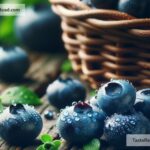Why Blueberries Have a Unique Color
Blueberries are tiny, round fruits full of flavor and nutrition. But one of the things that makes them stand out is their beautiful, deep blue color. Whether you see them piled high in a bowl or sprinkled over your favorite dessert, blueberries always catch your eye with their unique appearance. But have you ever wondered why blueberries are blue? Here, we’ll take a closer look at what gives these delicious fruits their special color, explained in simple terms.
The Science Behind the Blue
The blue color of blueberries comes from natural pigments called anthocyanins. These pigments are a type of compound found in many plants—especially fruits, vegetables, and flowers—and they give certain foods their shades of blue, purple, or red.
Anthocyanins are part of a larger group of molecules called flavonoids, which serve many important roles in plants. One of their jobs is to help protect the plant against stress from the environment, such as strong sunlight, pests, or lack of water. In blueberries, anthocyanins create the rich blue color that we recognize.
Interestingly, anthocyanins aren’t just responsible for color—they’re also packed with health benefits. These pigments work as antioxidants in the human body, helping to fight off harmful molecules, known as free radicals, which can damage our cells. So when you eat blueberries, you’re not only enjoying their unique look and taste, but you’re also boosting your health.
How Do Anthocyanins Create Color?
You might be wondering: How do anthocyanins produce that vibrant blue shade? It all comes down to chemistry. The color of anthocyanins depends on factors like pH levels (how acidic or alkaline something is) and the presence of other compounds.
Inside blueberries, the environment around the anthocyanins is slightly acidic. This specific pH interacts with the pigments to produce the blue hue. If the environment were less acidic, the fruit might look purple or red instead. For example, you may have noticed that other fruits like raspberries and strawberries, which contain anthocyanins too, have red or pink tones because their pH levels are different.
Interestingly, the skin of the blueberry usually has the highest concentration of anthocyanins. When you bite into a blueberry, you might notice the inside is more greenish or grayish than blue. That’s because the inside of the fruit contains fewer pigments. The deep blue we admire comes mostly from the outside layer.
Why Blueberries Look Frosty
Along with their blue color, blueberries often have a whitish, powdery layer on their skin. This isn’t dirt or something you need to wash off—it’s actually a natural coating called the bloom. The bloom is a waxy substance that protects the fruit from moisture loss and shields it from damage, like bacteria or pests.
The bloom also enhances the appearance of blueberries, giving them a slightly frosted look. This makes their blue color appear softer and more muted than other brightly colored fruits. It’s one of the reasons blueberries have such a unique and appealing look compared to, say, shiny red cherries or golden-yellow bananas.
How Growing Conditions Affect Color
The color of blueberries can also vary slightly depending on where and how they’re grown. Factors like soil type, sunlight, water, and temperature can influence the concentration of anthocyanins in the fruit. For example:
– Blueberries grown in sunny areas may develop a deeper color because sunlight triggers the production of pigments.
– Soil quality can affect the acidity levels around the plants, which might slightly change the shade of blue.
– The variety of blueberry—there are several types—can also impact how vibrant or dark they look.
Farmers and scientists have studied blueberries carefully to understand how to grow the most colorful and flavorful fruits. They’ve even bred different varieties to bring out specific traits, such as sweetness, size, or color intensity.
The Beauty in Nature’s Design
Blueberries aren’t just blue for the sake of looking pretty; their color serves a practical purpose in nature. The bright blue hue attracts birds and other animals, which eat the berries and help spread their seeds far and wide. This is how blueberries ensure their plants can grow and thrive in new areas.
Humans, too, are naturally drawn to the appealing color of blueberries. Whether we’re adding them to a smoothie, tossing them onto a salad, or enjoying them straight from the carton, their unique look often makes them the star of the dish.
Conclusion
Blueberries have a color that’s as fascinating as it is beautiful. The secret lies in their anthocyanins, natural pigments that respond to the fruit’s acidic environment to create the deep blue shade we love. Combined with the protective bloom on their skin, this unique color makes blueberries one of the most striking and appealing fruits around. Plus, their pigments don’t just add beauty—they provide health benefits that make blueberries a powerhouse superfood.
So, the next time you enjoy a handful of blueberries, take a moment to admire their special color. It’s more than just a pretty face; it’s the result of amazing science and nature working together.

